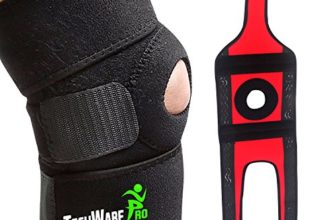
Have you ever found yourself searching for a remedy to reduce the swelling and pain after a sudden injury? Ice packs have long been the go-to solution for injuries and chronic pain. Not all ice packs are created equal, however. With a myriad of options out there, choosing the best one for your needs can be daunting. To help you decide, we have extensively reviewed numerous products, read through thousands of consumer reviews, and garnered advice from medical professionals to present you with our top picks.
Our Top Picks
Our #1 Top Pick: Chattanooga ColPac Reusable Gel Ice Pack
The Chattanooga ColPac Reusable Gel Ice Pack stands out for its superior quality and effective pain relief. Designed for clinical use, this ice pack delivers up to 30 minutes of cold therapy without the stiffness associated with freezing, thanks to its unique gel formula. Its versatility allows you to use it on various body parts, and the blue vinyl covering ensures its durability and easy cleaning. The ColPac comes in several sizes, but their standard size is particularly popular for its manageability and coverage area.
Pick #2: TheraPearl Color Changing Hot & Cold Pack
For those who appreciate visual cues, the TheraPearl Color Changing Hot & Cold Pack is a standout. Not only does it serve as both an ice and a heat pack, but it changes color based on its temperature, letting you know at a glance if it’s ready for use. Its pliable when frozen, ensuring a comfortable fit around limbs and joints. The combination of its versatile functionality and the color-changing feature makes this pack a favorite among users.
Pick #3: Mueller Ice Bag
Those who prefer a more traditional approach may gravitate towards the Mueller Ice Bag. It employs a simple fill-and-use system that can accommodate ice cubes or crushed ice. The pack is made of durable, leak-proof fabric, and the wide opening makes it easy to fill without spillage. The affordability and straightforward design make it a practical choice for home use, particularly for icing acute injuries like sports sprains.
Pick #4: FlexiKold Gel Ice Pack by NatraCure
The FlexiKold Gel Ice Pack by NatraCure is lauded for its gel consistency that remains flexible even when frozen, perfectly contouring around the affected area. With a double-sealed construction, its robustness is dependable for heavy-duty usage. The gel ice pack comes in several sizes, but its extra-large version is praised for covering substantial areas like the back or thigh. Regular use by physical therapists underlines its professional endorsement.
Pick #5: Arctic Flex Neck Ice Pack
Addressing neck pain specifically, the Arctic Flex Neck Ice Pack wraps comfortably around your neck to deliver soothing cold therapy. The pack stays in place with its velcro strap, which is a boon for anyone who needs to move around while icing. The gel pearls mold to your neck providing consistent coverage, and the soft velvet exterior adds a touch of comfort during use. It’s an excellent option for those with recurring neck pain or tension headaches.
What to Know Before You Buy
- Types of ice packs: Be aware that ice packs can be gel-based, chemical-based, or simply plastic or fabric bags designed to hold ice. They can also vary in terms of reuse-ability, with some being single-use and others designed for long-term use.
- Intended use: Consider whether you need the ice pack for general use or a specific body part. Some are specifically shaped to contour to areas such as the neck, knee, or back.
- Duration of coldness: Check how long the ice pack can stay cold. Medical professionals typically recommend 15-20 minutes of ice treatment, but some packs can provide longer lasting coldness.
- Comfort and flexibility: When frozen, some ice packs remain flexible, while others can become quite rigid. For a more comfortable experience, look for an option that conforms to your body.
Factors to Consider Before Buying
- Size and coverage: Ensure the ice pack covers the entire injured or painful area adequately. A mismatch in size could affect the efficacy of the treatment.
- Reusability: While single-use ice packs can be handy for on-the-go, a reusable ice pack is often more economical and environmentally friendly in the long run.
- Materials and durability: Look for materials that are durable and can withstand frequent use. Some packs have a soft outer layer for added comfort against the skin.
- Leak-proof design: A well-sealed ice pack is crucial to prevent leaks and spills that can create a mess and be uncomfortable during use.
- Ease of maintenance: Consider how easy the ice pack is to clean, as this will be important for hygiene especially if it’s used frequently or by multiple people.
Why Trust ChooseRight?
At ChooseRight, we are committed to providing accurate and unbiased reviews to help you make informed purchasing decisions. For our review of the best ice packs for injuries, we’ve considered the needs and experiences of users like you. Our team has poured over thousands of customer testimonials, engaged with product discussions, and sought insights from professionals in sports therapy and medicine to understand which products perform best under varying circumstances.
Our goal is to present options that cater to a wide range of needs, whether that be for a one-time use after a minor injury or for chronic conditions requiring regular care. Our recommendations reflect the efficiency, durability, and user satisfaction associated with each product, ensuring that you can trust them for your comfort and recovery.
Finishing Thoughts
Choosing the right ice pack can significantly impact your comfort and recovery time following an injury. It’s important to select a product that not only addresses your specific needs but also offers the convenience, reliability, and longevity you deserve. With our top picks, we’ve provided you with a variety of options that are well-regarded by both consumers and healthcare professionals. Remember to consider your individual circumstances and preferences when selecting an ice pack, and don’t hesitate to consult with a healthcare provider for personalized advice.
By trusting our comprehensive review, you can feel confident in your choice and focus on what’s most important—your healing and well-being.
Frequently Asked Questions
What types of injuries are ice packs most effective for?
Ice packs are most effective for treating acute injuries such as sprains, strains, bruising, and swelling. They can help to reduce inflammation and numb pain in the affected area.
How long should I apply an ice pack to an injury?
It is generally recommended to apply an ice pack to the injured area for about 15-20 minutes at a time. This can be repeated every 2-3 hours for the first 24-48 hours after the injury occurs.
Can I apply ice directly to my skin?
No, you should not apply ice directly to your skin as it can cause frostbite and damage the skin. Instead, wrap the ice pack in a thin cloth or use an ice pack with a protective cover.
How can I choose the best ice pack for my injury?
Look for ice packs that are flexible, easy to use, and can cover the affected area adequately. Some ice packs are also designed with straps or wraps to keep them in place. Additionally, consider the duration of cold the pack can provide and whether it’s reusable.
Are reusable or disposable ice packs better?
Reusable ice packs are generally more cost-effective and environmentally friendly as they can be used multiple times. However, disposable ice packs are convenient for one-time use or when a freezer isn’t available to re-chill a reusable pack.
Is it possible to use ice packs for heat therapy as well?
Some ice packs are designed to be versatile and can be used for both cold and heat therapy. Check the product specifications to ensure it is safe for heating, and follow the manufacturer’s guidelines for warming it up.
What should I do if I experience increased pain or discomfort while using an ice pack?
If you experience increased pain or any adverse reactions while using an ice pack, you should remove it immediately and consult with a healthcare professional to ensure proper treatment and care.
Are there any risks associated with using ice packs for injuries?
When used correctly, ice packs are relatively safe. However, improper use, such as applying ice for too long or directly to the skin, can cause frostbite, nerve damage, or skin irritation. Always follow proper guidelines and consult with a physician if you have concerns.
How do I care for and store my reusable ice pack?
Store your reusable ice pack in the freezer between uses, following the manufacturer’s instructions. Keep it clean by wiping it down with a disinfectant after each use, and check it regularly for leaks or damage.
Can children use ice packs for injuries?
Yes, children can use ice packs for injuries, but it is important to supervise their use to ensure the ice pack is not too cold or left on for too long. It may also be advisable to use a cloth barrier between the ice pack and the child’s skin to prevent cold injuries.







